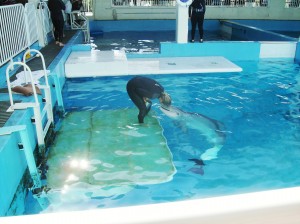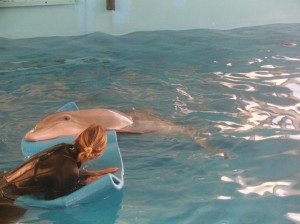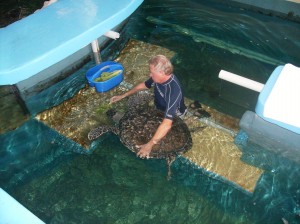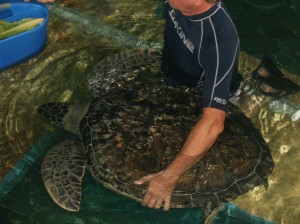12/11 My Dolphin Tale
Earlier this year we saw the movie A Dolphin Tale. It is a lovely family movie based on actual events. In December of 2005, an injured three month old dolphin washed up on shore. Rope from a crab trap had wound around the dolphin’s tail, injuring it very badly.
Under the care of the Clearwater Marine Aquarium, the dolphin they had named Winter, slowly began to heal from her injuries. It became quickly evident however, that Winter, whose tail needed to be amputated, would soon develop further spinal injury if she was not able to swim properly. Enter the help of nearby prosthetists, who changed everything for Winter’s outlook for success.
(The following is the remainder of the story from an article in the Washington Post written by Ellen McCarthy. It is SO compelling and beautifully written that I wanted you to experience it in its entirety)
Kevin Carroll (a world leader in prosthetics) and a colleague, Dan Strzempka, both prosthetists with Hanger Orthopedic Group who happened to live in Florida, quickly committed themselves to the project. They had built prosthetics for birds, horses and dogs before, but never a dolphin.
Carroll and Strzempka, working pro bono, first had to figure out whether a fake tail would even help Winter. The dolphin could still swim on her own, despite losing her entire tail and two vertebrae. She had adapted, learning to swim side to side, the way a fish or shark would, rather than with the up-and-down motion natural to dolphins.
She couldn’t swim as fast or jump as high as most dolphins, but the real problem was that she was slowly damaging her spine. “She started to develop scoliosis,” says Carroll. “So we felt that by fitting her with a prosthetic device, we could get her swimming in an anatomically correct manner again.”
The challenges in creating such a device were manifold. The sockets of most prosthetics fit over arm or leg bones, and need not be flexible. This one would attach to the end of Winter’s body, and had to move side to side, up and down and gently twist as she swam.
It also needed to attach securely to her stump. This was particularly difficult, Carroll explains, because Dolphins have hypersensitive skin. “Human skin is fragile, but I can scratch my nail across my skin and in a couple of minutes that mark is gone,” he says. “But if I put that same mark on the dolphin’s skin, six weeks later I’d come back and that mark would still be there.”
They initially tried a silicone-based material as the adhesive lining for the prosthetic. Because Winter didn’t have the ability to articulate what was painful or irritating for her, they used heat-detecting cameras to pinpoint areas of sensitivity and found that with the silicone, she was developing hot spots of discomfort.
Carroll and Strzempka, an amputee who lost his own leg in a lawn-mowing accident as a child, went back to the drawing board and worked with a chemical engineer to develop a new material, nicknamed “WintersGel,” that would distribute the pressure more evenly.
Strzempka tested it on himself first and when they put it on Winter, they didn’t pick up any hot spots. The team began preparing the dolphin for her new prosthetic, starting with a very small tail so she slowly became reaccustomed to the sensation of its resistance in the water. Trainers acted as physical therapists, coaching her to once again move her body up and down. Over the course of a year, the team gradually increased the size of the tail to match her now 230-pound body, and Winter began swimming as she had before the accident.
“We knew it was going to happen, but when it happened, it was just awesome,” Carroll says of the first time Winter used the full prosthetic. “Just to see this very clean, anatomically correct, fluidlike motion in the water — it was absolutely breathtaking.”
Eventually, the prosthetists realized WintersGel would work on humans. Carroll recalls one child in particular who benefited from the innovation. The 9-year-old girl had been badly burned as a baby and had to have her legs amputated. She wouldn’t wear her prosthetics because they were too painful against her sensitive scar tissue, so she was using a wheelchair. Carroll met with her, told the little girl about Winter and fitted her with a new sleeve made of WintersGel. “So now, a year and a half later, she’s flying around,” on her prosthetic legs, says Carroll.
An unbelievable story of caring and perseverance. During our recent trip to Florida we went to the Clearwater Marine Aquarium and saw Winter in person. We watched an entire physical therapy session, with and without her tail. She is so beautiful. She is so alive and gracious like a shelter dog or cat.
After physical therapy her trainer gave her a human sized foam mattress and she flopped on top of it like a sun bather and relaxed while floating. It was so magnificent. I stood there in awe and could hardly believe that I was witnessing the same dolphin from the movie. I also had the opportunity to touch the WintersGel that has helped so many humans with their own prosthetics. It was humbling and exciting to realize that because of this dolphin, human amputees may also be more comfortable.
The Marine Aquarium is a true hospital. They work toward rehabilitation and release for those that are able to once again thrive on their own. For those that can not, they live out the rest of their lives there. It is a refuge for forgotten and injured marine life and it felt like a great honor to be there.
While there, I fell madly in love with a particularly large sea turtle named Cocoa. He is blind from being struck on the head by a boat near Cocoa Beach. I watched as a man held him close and hand fed him romaine lettuce and fish.
I was so overcome that I turned to Sandy and exclaimed in sheer madness and joy, ” I can’t believe I am going to work here!” I have no idea where that came from, but there it was with as much conviction as my stating…yes, I am a woman! I felt connected there and at home.
Spending the day at the Marine Aquarium was an encouraging reminder of how much people do care about animals. The animals there do not do tricks or jump through rings. They are maimed, scarred and need care. Yes, there is one very famous dolphin there, but the price of admission helps care for every living thing there and that is wonderful. The Aquarium was full of volunteers, trainers and visitors dedicated to and interested in the preservation of marine life.
It was also a powerful reminder that living things hurt, can become injured, require care and love to recover. They are not insignificant or incidental to our own experiences on Earth. They are sharing the oceans with us. They belong there, we are their guests. Let us all be courteous guests.
Have a delicious day.
Dolphin Tale movie image courtesy of iceposter.com
Tags: A Dolphin Tale, Clearwater Marine Aquarium, compassionate eating, Dolphin Tale, Kevin Carroll, plant based diet, prosthetic dolphin tail, vegan experience, vegan wannabe, Winter the Dolphin, WintersGel






December 11th, 2012 at 5:50 pm
So inspiring Sherry! Thank you for sharing!!